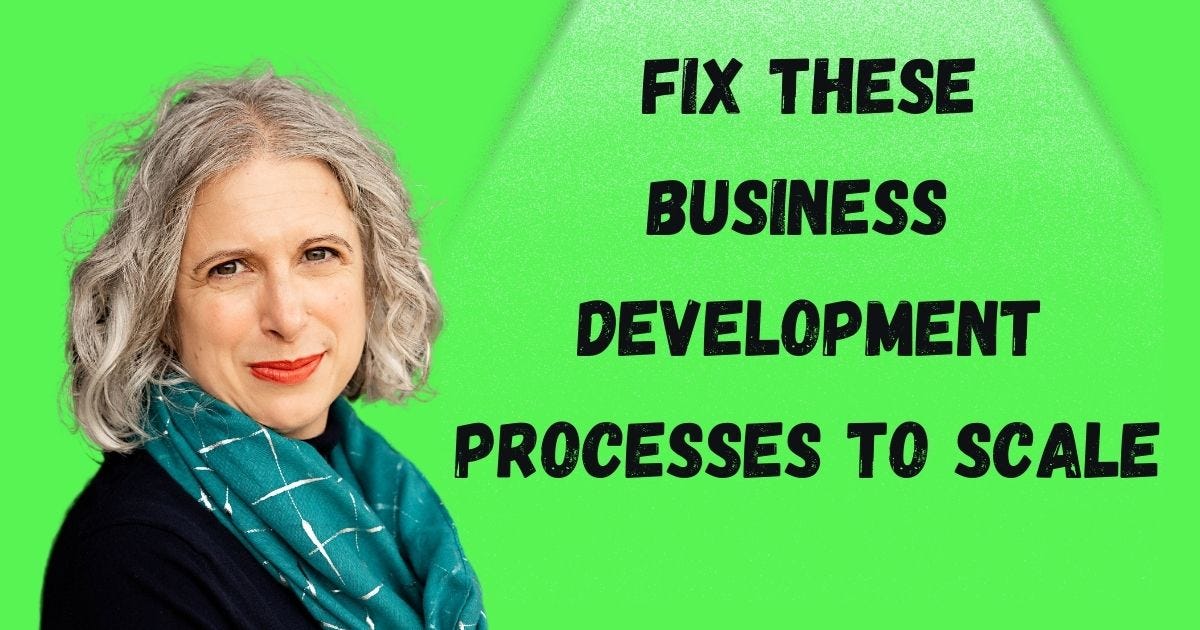Welcome to a free edition of Start Up To Grown Up: Your source for ideas, insights and tactics to take back control of your business and scale it sustainably and profitably by Heather Townsend, award-winning author of The Accountants’ Millionaires’ Club and Founder of The Accountants’ Growth Club
I’ve got a confession to make.
Our business’s marketing is broken right now. Well, not properly broken, but broken enough that it needs some serious attention.
There are various reasons for my woes. Some of it is due to AI, meaning we can no longer rely on ready-made clients to find our websites via a Google search. (This will be the topic of another article.) Some of it is that I’m still unpicking the damage caused by a marketing manager who didn’t know what they were doing.
However, unless all the processes within your business development activities, i.e. marketing, sales and account management, are working well, then you will struggle to scale your business.
This is what this article is about. How to get your sales, marketing and account management to just work without you needing to spend hours and hours networking or seeing very little return for your marketing spend.
Why is scaling a knowledge or professional services business so hard?
Most clients have come to your firm because of you. You are seen as the expert and, quite rightly, they want to work with you. But the problem is, there is only one of you. Every hour you spend on client work is an hour you can’t be working ON the business or doing business development.
Here is the truth. To scale sustainably, you cannot rely on working harder. You need a simple, solid system that supports you, helps you attract and convert the right clients, and gives your business the stability to grow without you having to carry everything on your shoulders.
Let’s break down what that looks like in practice.
Nail your hygiene factors
When it comes to generating more of the right type of new business we often think about tactics. For example, do we need to book more meetings with clients or introducers? Do we need to produce more articles or secure more speaking opportunities? However, before you do this you need to sort out, what I like to call, the hygiene factors.
Hygiene factor: Know your client
How well do you really know your ideal client? It is not enough to say your target client is “large businesses" or "local companies" or “women over 50 who want and need more”. You need to dig deeper. What type of small business owner? What industry are they in? Or is it sector agnostic? What stage of growth are they at? Where are they personally? What are their headaches, ambitions and buying triggers? What challenges does your solution help them solve? What is the value to them personally? Without this clarity, your marketing will struggle and the leads you do attract are often price-sensitive and difficult to convert.
Hygiene factor: Matching your activities to the client’s buying journey
Your clients don’t wake up in the morning and think - I know, I’ll buy from them today. They normally go through a pre-ordained set of steps to get to the point where they send you a message along the lines of “I think I may need your services.” When you know what your ideal client is thinking as they go through their buying journey, you can align your sales, marketing and account management processes to their journey. This typically means more of the right type of business comes your way. When you are helping people buy, it feels far more natural and collaborative to be working with a prospect. It also makes the sales part of business development feel much less ‘icky’. After all, who wants to be seen as a salesperson?
Hygiene factor: Have a credible online presence
At one point in time, it was all about your website. And yes, your website is still important. However, with the decline of search engine traffic due to the influence of AI, the reality is that you need to think about your total online presence. From your website to your social media profiles, and then any online directories you are listed in. The messages and narrative that go through each part of your firm’s online presence -whether or not this is via your personal brand - need to be congruent and aligned with the type of client you want and the work you want to do with them.
Even if you get most of your new business by referral, your online presence is still essential to have optimised. These days, almost every buying decision starts with a recommendation followed by a quick Google search. When someone checks you out, does your website and LinkedIn profile reinforce the right impression? If not, even warm referrals can go cold fast.
Hygiene factor: Listening to and capturing client feedback
Another essential hygiene factor is capturing client feedback consistently. Happy clients are one of your biggest growth assets, but only if you are intentional about maintaining service quality and spotting opportunities to improve. A simple monthly review of client feedback, followed by real action, can make a bigger difference than any marketing campaign. For example, our biggest ‘selling’ points for The Accountants’ Growth Club have all come from feedback from our members. Every 2-3 months every member is asked about their experience with the club and how we can improve. Our new AI group and switching to WhatsApp rather than Facebook groups have all come about as a result of feedback from members.
Hygiene factor: Involve all your team
Finally, make sure you are not trying to do it all alone. Every member of your team should have a small, clear role in supporting your sales and marketing system. Even if it is just making sure client onboarding runs smoothly or helping gather testimonials, it all counts.
Build your core business development systems and processes
Getting the hygiene factors right gives you a strong foundation. But to grow reliably, you also need some simple systems that run in the background. Systems that help you move from random bursts of growth to steady, sustainable progress. When you can rely on your pipeline of new business converting at a constant rate, you then have the confidence to hire or bring in the right resource to help you service the work.
The first system to build is your lead generation system, i.e. marketing. Without leads coming in regularly, it is hard to predict or plan anything. Your lead generation system should feel achievable, not overwhelming. Pick two or three routes to market you can commit to. Maybe it’s staying visible on LinkedIn, keeping in touch with former clients, and having regular coffee catch-ups with introducers. It does not have to be complicated, but it does need to be consistent.
Then, you need to think about your lead conversion system, i.e. sales. In simple terms, this is how you take someone from "interested" to "paying client". It could be a short discovery call, followed by a proposal and a follow-up email. Or it may be a formal response to a request to tender. It does not need to feel "salesy". In fact, the more you guide people naturally through their decision-making process, the less it feels like selling. Remember, your aim is to help people buy rather than sell to them.
Onboarding is another key system. How you start a relationship often sets the tone for everything that follows. A clunky, disorganised onboarding process can undo all the trust you built during the sales process. Whereas a smooth, thoughtful onboarding experience reassures clients that they made the right choice. Get the onboarding right, and there usually are opportunities to sell more business to your new client, either to them directly or via a referral from them.
Finally, a straightforward account management process will help you retain clients for longer and spot additional ways you can help them. It might just be a quarterly check-in call or a quick note after a project is completed. But showing clients you are thinking about them makes a difference. It also opens the door to more work without you having to "sell" again.
If you are going to move effortlessly to scaling, your account management process is key. After all, winning new clients all the time involves a heavy price to pay in terms of time and cost. If you can effortlessly generate new business via your existing clients who know and love you, why wouldn’t you focus on this? But account management isn’t just about expanding from existing clients; it’s about maintaining your current client base. There is no point in winning lots of new business just to see it leave out the back door.
After 15+ years running a coaching and training business, I have realised life is a lot easier when I can move clients from discrete, time-bound coaching assignments through to a business model that involves monthly recurring income. For example, being the coach a business calls when it needs help with a key individual. Or as we have done with the Accountants’ Growth Club, moving from a ‘pay by hour model for coaching’ to a monthly subscription service.
Being realistic some of the these processes will remain your responsibility for a while. After all, I am aware that I can’t duck out of going hard on strengthening my personal brand right now. This means you do need to make time for business development.
Delegate and outsource sooner than you think you need to
If there is one thing I wish I had done earlier, it is getting help before I felt 'ready'. Because here’s what often happens. You get busy, tell yourself you’ll outsource when things calm down, but then you never quite get there.
Building support around you before you hit breaking point is one of the smartest moves you can make. It does not have to be big. Maybe it’s a VA helping you triage your inbox. Perhaps it’s a marketing freelancer keeping your LinkedIn ticking over.
One of our members recently outsourced their social media posts for just £250 a month. That one small step doubled their local referrals in just three months. They did not overhaul their business. They just freed up some time and headspace. It made a real difference.
If you are feeling underwater, a small shift could give you back more breathing space than you think.
It is worth asking yourself: "What is one thing I am clinging on to that someone else could do instead?"
Measure and monitor
How did I know that our marketing was broken? It was because I was monitoring sign-ups to our email list. Without that data, I wouldn’t have known there was a problem. Given that the majority of our new clients come from people who have known us for a while but are not yet ready to buy. The folks I like to put in the “not yet” camp. This means that the health of our email list is something that I monitor obsessively.
Question: What are you monitoring with your business development? After all, new clients won or leads generated can only tell you so much. Are the key processes behind your lead generation working as planned?
Why these systems matter more than ‘hustle’
It is easy to believe that if you just work a bit harder, everything will slot into place. But if you are anything like me, you have probably realised that hustle will only get your business so far. And normally to a place where you feel burnt out.
Processes are what make growth sustainable. They create rhythm and reliability in your business. They mean that even if you have a tough week, or you need to step away unexpectedly, such as the weeks I have been out working at under normal capacity due to my recent ankle surgery, things do not fall apart.
When you get your processes working, growth stops feeling fragile, and you can move to scaling your business. It stops depending entirely on you showing up at 100% energy every single day. From a personal perspective, this journey as a business owner becomes steadier, calmer, and much more enjoyable.
Final thoughts
Consistently winning the right type of new business doesn’t come down to luck or one thing. It involves getting your hygiene factors sorted and then ensuring that your marketing, sales and account management processes are all working together seamlessly. If one of these processes stops working then you are jeopardising the future growth of your business.
Your actions this week:
Critically look at your business development processes. Which ones are key? How are you making sure that they are carried out? What KPIs do you need to measure to get a warning system of problems?



















Share this post